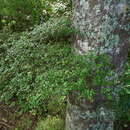en
names in breadcrumbs


Ko te Tāwhai pango he rākau whakakake o Aotearoa. He momo tāwhai, he ririki, he matahua ngā rau, he hinauri te tīwai. He ingoa reo Māori anō, arā, he Tāwhai rauriki. Ko te ingoa pūtaiao ko Nothofagus solandri. Ko te ingoa i te reo Pākehā he Black Beech.
Ko te Tāwhai pango he rākau whakakake o Aotearoa. He momo tāwhai, he ririki, he matahua ngā rau, he hinauri te tīwai. He ingoa reo Māori anō, arā, he Tāwhai rauriki. Ko te ingoa pūtaiao ko Nothofagus solandri. Ko te ingoa i te reo Pākehā he Black Beech.
Nothofagus solandri, commonly called black beech, is species of tree endemic to New Zealand. Black beech occurs on both the North and the South Island at low elevations up to the mountains. It is also known as Nothofagus solandri var.solandri. In New Zealand the taxon is often called Fuscospora solandri.[3]
Black beech is a medium-sized evergreen tree growing to 27 m tall. The leaves are oppositely arranged, ovoid, 10 mm long and 5 mm broad, with smooth margins.
Black beech is known as black beech because it is prone to a sooty mold which covers the trunk and branches. This, in turn, is the result of a scale insect which sucks sap from the tree, and excretes honeydew, a sweet liquid, in small droplets (less than 1 mm diameter) on the end of stalks. This feeds the sooty mold, and also forms a valuable high-energy food source for various birds and insects including the kaka. The infestation is common and does not appear to harm the tree.
Black beech and mountain beech have both been planted in Great Britain, and mountain beech has shown better cold tolerance than black beech in locations such as Scotland.[4]
Nothofagus solandri, commonly called black beech, is species of tree endemic to New Zealand. Black beech occurs on both the North and the South Island at low elevations up to the mountains. It is also known as Nothofagus solandri var.solandri. In New Zealand the taxon is often called Fuscospora solandri.
Black beech is a medium-sized evergreen tree growing to 27 m tall. The leaves are oppositely arranged, ovoid, 10 mm long and 5 mm broad, with smooth margins.
Black beech is known as black beech because it is prone to a sooty mold which covers the trunk and branches. This, in turn, is the result of a scale insect which sucks sap from the tree, and excretes honeydew, a sweet liquid, in small droplets (less than 1 mm diameter) on the end of stalks. This feeds the sooty mold, and also forms a valuable high-energy food source for various birds and insects including the kaka. The infestation is common and does not appear to harm the tree.
Black beech and mountain beech have both been planted in Great Britain, and mountain beech has shown better cold tolerance than black beech in locations such as Scotland.
Nothofagus solandri, el haya negra de Nueva Zelanda,[1] es una especie arbórea de la familia de las Notofagáceas o "hayas del Sur".
Se trata de una especie endémica de Nueva Zelanda, donde crece tanto en la Isla Norte e Isla Sur. Tiene dos variedades:
El haya negra (var. solandri) es un árbol perennifolio de 27 m de alto. El haya de montaña (var. cliffortioides) es más pequeño (20 m) y cerca de la línea arbórea forma un "bosque duende" donde los árboles no miden más de 2 m de alto.
Las hojas son alternadas, ovoides, 10 mm × 5 mm, con márgenes lisos. En la var. cliffortioides las hojas son más elongadas y puntiagudas, mientras la var. solandri las tiene más cortas y redondas. Hay sin embargo una variación considerable en la forma de las hojas en las variedades, porque hay hibridación entre ellas.
La var. solandri es conocida como haya negra porque es susceptible al moho de hollín (sooty mold) el cual cubre el tronco y las ramas. Este a su vez es el resultado de un insecto de la familia de las coccoideas el cual succiona savia del árbol, y excreta un rocío de miel en forma de un líquido suave en pequeñas gotitas (menos de 1 mm de diámetro) al final de los tallos. Esto incrementa el moho de hollín, y también es una valiosa fuente de energía para varias aves e insectos incluyendo el kaka. La infestación es común y no parece dañar el árbol.
Ambas variedades han sido plantadas en la Gran Bretaña y var. cliffortiodes ha presentado mejor tolerancia al frío en lugares como Escocia.[2]
Nothofagus solandri fue descrita por (Hook.f.) Oerst. y publicado en Skrifter Udgivne af Videnskabs-Selskabet i Christiana. Mathematisk-naturvidenskabelig Klass 5(9): 355. 1873.[3]
Nothofagus: nombre genérico compuesto de notho = "falso" y Fagus = "haya", nombrándolo como "falsa haya".[4]
solandri: epíteto
Nothofagus solandri, el haya negra de Nueva Zelanda, es una especie arbórea de la familia de las Notofagáceas o "hayas del Sur".
Le hêtre noir (Nothofagus solandri) est un arbre endémique de Nouvelle-Zélande.
Juodasis notofagas (lot. Nothofagus solandri) – monotipinės notofaginių (Nothofagaceae) šeimos visžalių medžių rūšis. Endeminė Naujojoje Zelandijoje (auga tiek Šiaurės, tiek Pietų saloje).
Aukštis iki 27 m, tačiau pakrantėse, kalnuose (medžių linijoje) augantys augalai teužauga iki krūmokšnio. Lapai pražangūs, kiaušiniški, 10 mm ilgio ir 5 mm pločio, lygiakraščiai.
Notofagas vadinamas juoduoju dėl dažnai kamieną ir šakas dengiančių suodinų puvenų. Jos susidaro dėl skydamarių, čiulpiančių augalo syvus ir išskiriančių medaus rasą.
Nothofagus solandri é uma espécie de árvore endêmica da Nova Zelândia. Possui duas variedades: Nothofagus solandri var. solandri e Nothofagus solandri var. cliffitoides.[1]
Nothofagus solandri é uma espécie de árvore endêmica da Nova Zelândia. Possui duas variedades: Nothofagus solandri var. solandri e Nothofagus solandri var. cliffitoides.